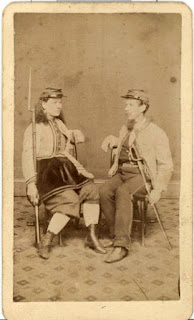
One side study I got into is the stages of dress for women during the Civil war era. It really came from an argument with a nice lady over if the chemise was tucked into the open inseam drawers or worn over them. Some reenactor ladies wear their underwear in public as an educational program and they wear them incorrectly from the period sources that I have found.
First the period written sources.
I used Emile Zola's Nana and a corresponding English Translation as the period is the late 1860s and Zola was alive during that time.
NANA, 1880
Nana est un roman d'Émile Zola publié en 1880, le neuvième de la série Les Rougon-Macquart, traitant le thème de la prostitution féminine à travers le parcours d'une courtisane dont les charmes ont affolé les plus hauts dignitaires du Second Empire. L'histoire commence en 1868.
Chapter Five
".....Et il but d'un trait. Le comte Muffat et le marquis de Chouard l'avaient imité. On ne plaisantait plus, on était à la cour. Ce monde du théâtre prolongeait le monde réel, dans une farce grave, sous la buée ardente du gaz. Nana, oubliant qu'elle était en pantalon, avec son bout de chemise, jouait la grande dame, la reine Vénus, ouvrant ses petits appartements aux personnages de l'Etat. A chaque phrase, elle lâchait les mots d'Altesse Royale, elle faisait des révérences convaincues, traitait ces chienlits de Bosc et de Prullière en souverain que son ministre accompagne. Et personne ne souriait de cet étrange mélange, de ce vrai prince, héritier d'un trône, qui buvait le champagne d'un cabotin, très à l'aise dans ce carnaval des dieux, dans cette mascarade de la royauté, au milieu d'un peuple d'habilleuses et de filles, de rouleurs de planches et de montreurs de femmes. Bordenave, enlevé par cette mise en scène, songeait aux recettes qu'il ferait, si Son Altesse avait consenti à paraître comme ça, au second acte de la Blonde Vénus....."
"....Then he drank it off. Count Muffat and the Marquis de Chouard had followed his example. There was no more jesting now--the company were at court. Actual life was prolonged in the life of the theater, and a sort of solemn farce was enacted under the hot flare of the gas. Nana, quite forgetting that she was in her drawers and that a corner of her shift stuck out behind, became the great lady, the queen of love, in act to open her most private palace chambers to state dignitaries. In every sentence she used the words "Royal Highness" and, bowing with the utmost conviction, treated the masqueraders, Bosc and Prulliere, as if the one were a sovereign and the other his attendant minister. And no one dreamed of smiling at this strange contrast, this real prince, this heir to a throne, drinking a petty actor's champagne and taking his ease amid a carnival of gods, a masquerade of royalty, in the society of dressers and courtesans, shabby players and showmen of venal beauty. Bordenave was simply ravished by the dramatic aspects of the scene and began dreaming of the receipts which would have accrued had His Highness only consented thus to appear in the second act of the Blonde Venus....""...Cette fois, Nana ne se retourna point. Elle avait pris la patte de lièvre, elle la promenait légèrement, très attentive, si cambrée au-dessus de la toilette, que la rondeur blanche de son pantalon saillait et se tendait, avec le petit bout de chemise. Mais elle voulut se montrer sensible au compliment du vieillard, elle s'agita en balançant les hanches...."
"...This time Nana did not turn round. She had taken up the hare's-foot and was lightly manipulating it. All her attention was concentrated on this action, and she bent forward over her toilet table so very far that the white round contour of her drawers and the little patch of chemise stood out with the unwonted tension. But she was anxious to prove that she appreciated the old man's compliment and therefore made a little swinging movement with her hips...."Next I had a French Canadian friend translate this passage from Corsets and Crinolines, Norah Waugh, Theater Arts/Methuen New York 4th printing.
French text by GYP, Souvenirs d'une Petite Fille (1927-28).
GYP was writing about her experiences in the 1860s
1861 Longchamps
"A big hubbub has occurred. It's an important prize. Women are climbing onto chairs. It's an ocean of hoopskirts that sway side to side, showing legs that at this time seem to me to be short and heavy, for the most part. Waists at this time, are without charm, too narrow between the too-well developed breasts and the too-big hips. This is explained by a deformation of the corset which makes them fashionable . . . At the end of the race, all the women brusquely lean forward, and the pressure of the hoopskirts against the chairs makes them sit up in back like a fan. Then we saw right up to the waist of the drawers which don't resemble each other like the legs . . . It's too hot and a majority of women don't wear the 'little skirt" between the drawers and the hoopskirt. I noticed, to my surprise, that which I had not before seen: little rags of material which hang ridiculously and pitifully. I pulled my uncle by the sleeve and showed him the objects of my astonishment. -What is this? -That said uncle in a somewhat discordant voice, is a chemise which comes out of open drawers. I repeated myself, more and more dumbfounded: -Open drawers . . . so, what good are drawers if they're open? Hearing uncle's brusque response, several women hurriedly got out of their chairs. I don't say "jumped" because, with the hard corsets, the whalebone stays, their movement lacked fluidity and rapidity." I understand that small children didn't wear open drawers at that time explaining GYP's question.







